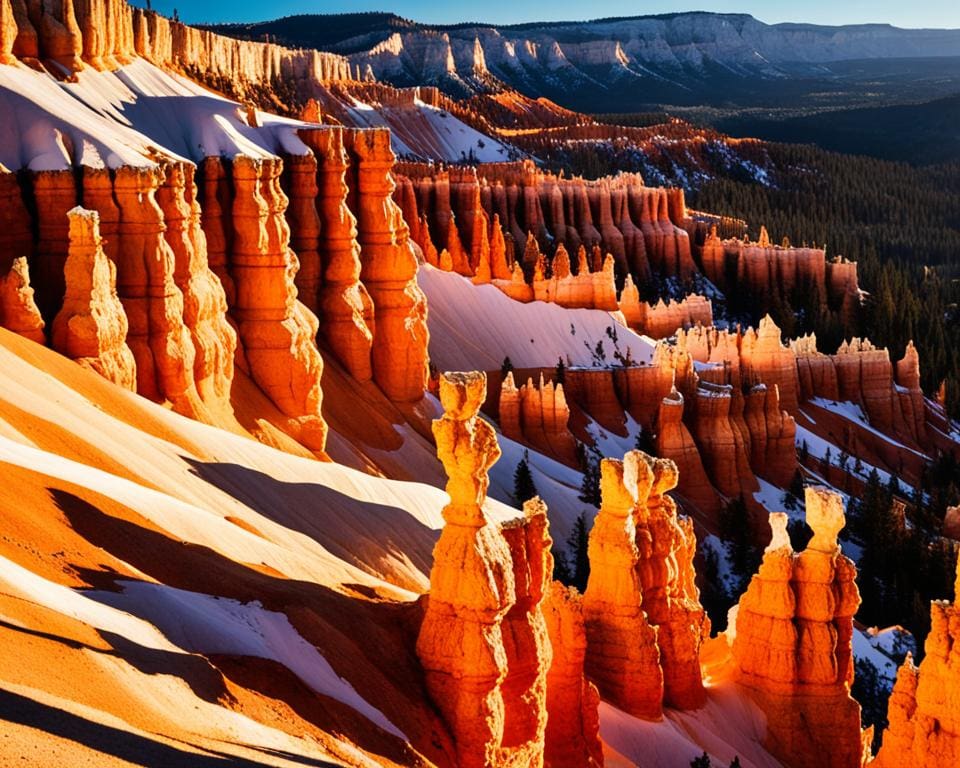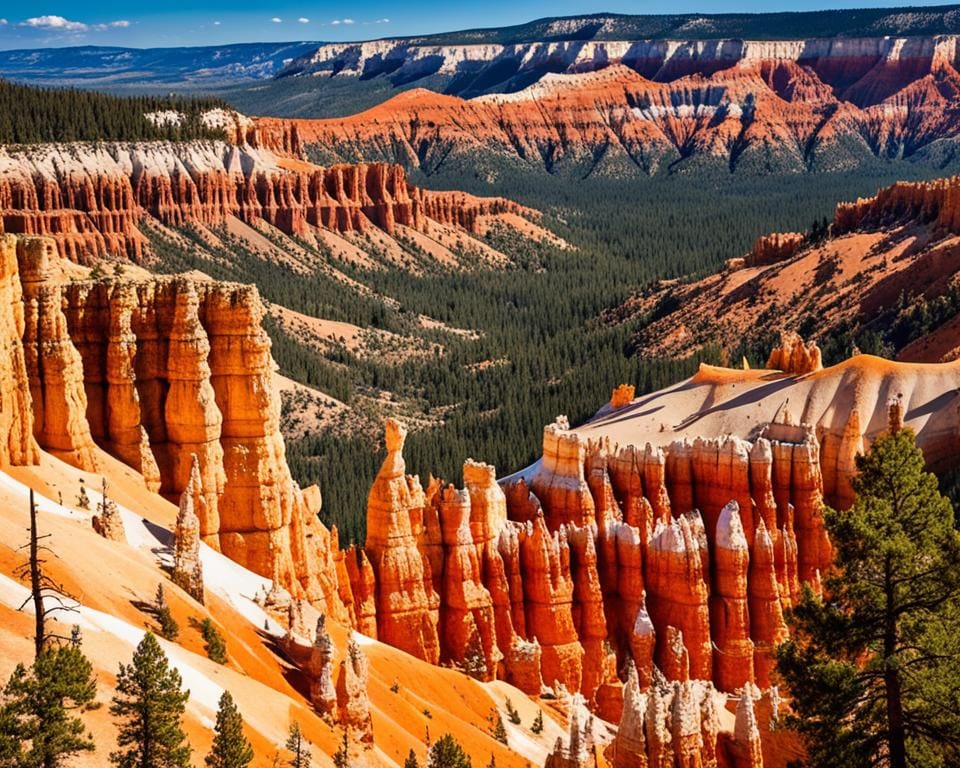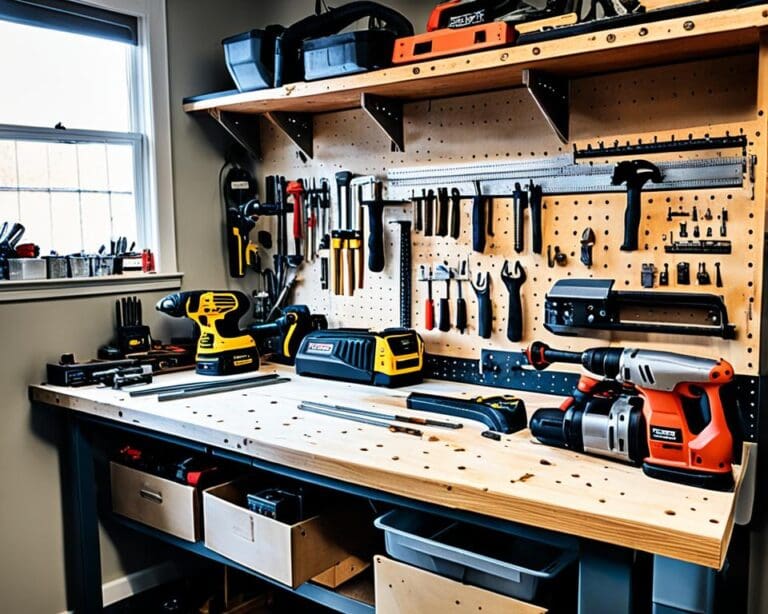Welcome to Bryce Canyon National Park. This amazing place is about 2.5 hours from Zion National Park in southern Utah. It’s known as one of the “five jewels of the American West.” Every year, about 2.7 million people come to see its stunning views. Bryce Canyon was established in 1928. It’s famous for its unique hoodoos—tall, thin rocks formed by nature over time.
Your adventure starts with the park’s 18-mile scenic drive. You’ll find lots of spots that show off the beauty of this area. This Visitor’s Guide will help you find the best places to see. And the best times to see breathtaking sunrises and sunsets at Bryce Canyon.
Exploring the Unique Geography of Bryce Canyon National Park
Bryce Canyon National Park is unlike any other place, with its amazing geological features. Visitors love the incredible hoodoos formations, rising from the valleys like towers. These formations show how nature’s forces have shaped the park over time, telling the Earth’s geological story.
Understanding Hoodoos: The Iconic Rock Formations
The hoodoos in Bryce Canyon National Park fascinate geologists and nature lovers. They were made by erosion, with water, frost, and wind playing key roles. These stone spires have unique shapes that sum up years of natural changes. Each hoodoo’s varied colors speak to the park’s rich geological past.
Geological History of Bryce Canyon
Bryce Canyon’s history is told through its rocks. This place is part of the Grand Staircase, with sedimentary rocks in many colors. Volcanic activity, uplift, and erosion have made the landscape we see today. Knowing this history makes a visit even more meaningful, as it shows the vast power of nature.
The Scenic Drive Through Bryce Canyon
Taking an auto tour through Bryce Canyon National Park offers stunning views. The 18-mile drive goes from the visitor center to Rainbow Point, with lots of places to stop. Highlights include Sunrise Point, Sunset Point, Inspiration Point, and Bryce Point. These spots offer incredible views of the Bryce Amphitheater and its hoodoos. It’s a chance to see the park’s beauty and make lasting memories.

Breathtaking Views at Bryce Canyon: A Visitor’s Guide
Bryce Canyon National Park is perfect for those who love nature. It has views that will take your breath away any time of the year. By choosing the best spots and times to visit, and knowing which trails are easy to walk, you’ll get the most from your visit to this beautiful place.
Key Scenic Overlooks
Bryce Canyon has several spots where you can see its beauty up close. Bryce Point offers wide views of the famous hoodoo formations. It’s a spot you shouldn’t miss. At both Sunrise Point and Sunset Point, you can see the park light up in amazing colors early in the morning and late in the day. Finally, Paria View shows off the park’s deep amphitheater, which is over 500 feet deep. Any of these viewpoints will amaze you with the park’s colors and shapes.
Best Viewing Times for Stunning Sunsets
The time of day you visit Bryce Canyon makes a big difference. Sunset is a magical time here. The setting sun fills the canyon with colors like orange, pink, and purple. Many visitors get completely absorbed by the beauty of the sunset. This makes the park feel even more special.
Accessible Trails and Viewpoints
Bryce Canyon makes sure everyone can see its wonders. Part of the Rim Trail is easy to walk and takes you to beautiful overlooks without having to climb much. The Navajo Loop Trail is also quite easy and lets you see the hoodoos from close by. These trails ensure that all visitors, no matter their hiking skill, can enjoy the park’s stunning views.
Must-See Hiking Trails in Bryce Canyon
Hiking in Bryce Canyon is a transformative experience. It allows visitors to dive deep into the stunning landscapes of Utah’s unique geological formations. The Navajo Loop Trail is especially noteworthy for its easy access and breathtaking views. This popular 3-mile trek takes you past intricate rock formations known as hoodoos. You get close-up views that make it a must-do in the park.
The Queens Garden Trail also offers an adventure. It connects smoothly with the Navajo Loop for a moderate yet rewarding journey. It showcases the picturesque amphitheater. For the more adventurous, the park has tougher trails like the ◼️Fairyland Loop Trail and ◼️Peek-A-Boo Loop. These trails have steeper climbs and amazing views but are less crowded.
Bryce Canyon’s elevation ranges from 8,000 to over 9,000 feet. It’s important for hikers to stay hydrated and wear the right shoes. You can choose from a short half-mile walk on the ·Mossy Cave Trail to longer backpacking routes. Each hike offers a chance to see the breathtaking beauty of Bryce Canyon National Park. Remember to consider the season, as conditions can affect trail access. Always check park maps and pick trails that fit your hiking level for the best time.









